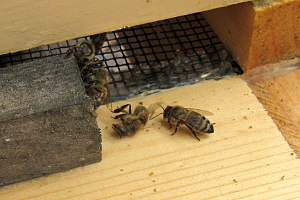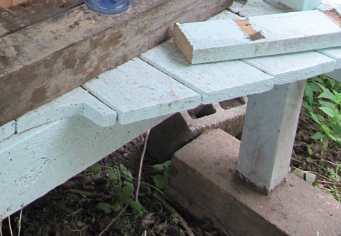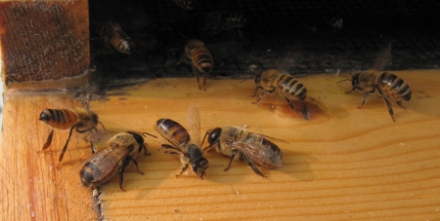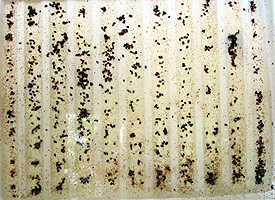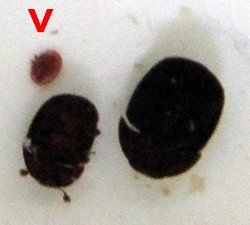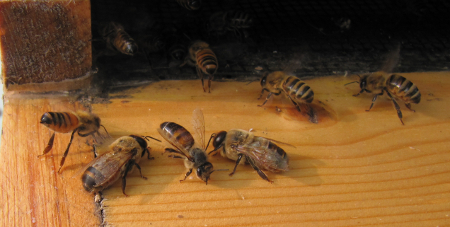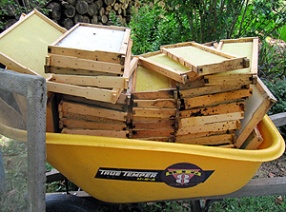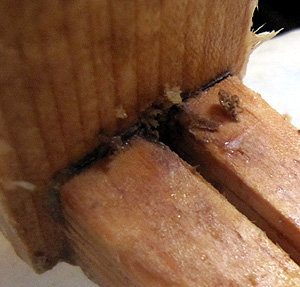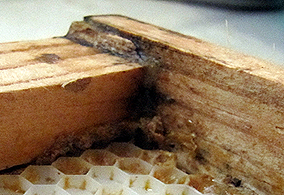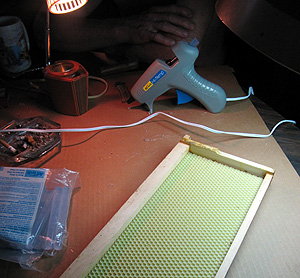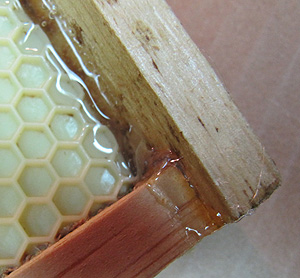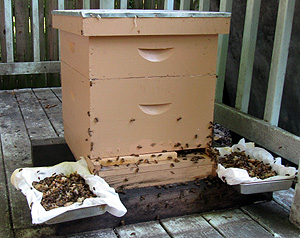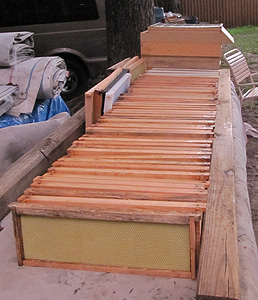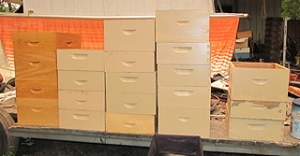One of my readers wrote to me asking advice (I added a few sentences later):
I just read your blog about hive beetle. We had them for the first time last summer. Noticed it when we found a huge pile of bees on the ground. Bees had been in that hive since spring. When we opened up the hive, we discovered a large amount of hive beetles. No other hive was disturbed. We have four hives. I installed another swarm a few weeks ago and they absconded. Was thinking about making the cd case trap. We cleaned out the box, burned the inside, and installed another swarm in the same box. Less than a week later, we had dead bees again all over the ground. No beetles, though. It is strange how this has happened, but will be destroying that box, but first will douse it with 50/50 bleach and water. No other signs of any disease or anything. You mentioned using roach bait, I have some of the powdered bait, would you suggest I sprinkle it on the ground near the back of the hives? Also, what kind of nematodes should I purchase? ~ Gloria
I know the feeling. You do all that work and there they are, a big mess. How are your other hives doing? Are they free of problems? In my case, after all of what I did to get rid of beetles I decided several things:
-
That I couldn’t tell if the nematodes did anything. And they are really expensive. So I decided not to get them a second year. Maybe the original ones are still alive in the soil and working. Who knows?
-
The beetle traps with poison in them didn’t catch anything at all. I don’t know why, but other people say the opposite. They catch beetles for them. I caught none.
- I forgot to add something. POWDERED SUGAR SHAKE! You put powdered sugar in a flour sifter or something similar, and shake this all over your bees and inner parts. It riles the bees up irritatingly, they attack whatever is in there. And it makes things slippery so that mites and whatever falls into your oil trap. Do this regularly, maybe once a month during fine weather. It’s non toxic, and the bees will eat the leftovers.
- OOPS! forgot something else my husband reminded me of. We have our hive up on a deck up off the ground. And several times a year we wrap the legs in rags and soak that in used transmission fluid and kerosene half and half. It keep ants and all kinds of things from crawling up to the hives. Additionally, my deck legs are sitting on concrete blocks for leveling. I douse these with oil too.
- Additionally, and this is very important. There must be enough bees in the hive to cover all of the frames, and chase the beetles and harass them.
Bees will corner beetles and keep them in corners and make it difficult for them to breed. They even resort to using propolis to wall them in. But if there is too much space, such as adding a super prematurely, and too little bees to cover the space, the beetles will be able to evade persecution, running in all directions and hiding in the cracks. This gives them ample time to lay eggs and multiply.
I think, if your other hives were not overcome with beetles they had a big enough population to defend and corral the beetles that they did get. It’s possible that your failed hive was the opposite, and even that beetles were not the original problem, but what weakened them enough to make them overcome with the beetles. So check for any other problems.
NOTE: My hives only had a few beetles one summer. I left for a week long vacation, after putting extra supers on all the hives hoping to prevent a swarming. When I came home the beetles had taken over all the hives. CAUSE: I gave them room to escape by putting the supers on too soon.
I also think that the powdered sugar shake, combined with the Freeman Beetle trap, and sucking the beetles up regularly with a low powered vacuum can keep the population down to manageable levels.
The Freeman oil Beetle Trap is different from other oil traps, in that it doesn’t have ledges at the bottom for varmints to hide and lay eggs in. Which leads me to my other article about sealing cracks in the hive. See my article on how I sealed the cracks permanently HERE
Probably using a combination of controls is what helped my beetle thing. But I think the sweeper was best. I never completely got rid of every single beetle, as they came back the next spring. (They overwinter in the hive, and hatch normally in the dirt outside the hive if not actively reproducing inside the hive) So the bees keep them warm for the winter. How convenient. What I did was to cut the population down to less destructive levels.
The way I used the sweeper was that whenever I opened the top lid of the hive to check or mess with the bees, I flipped it over quickly and vacuumed any beetles running around as quick as I could, dodging bees all the while (it WILL suck up bees too). Then I switched to the inside top of the hive and chased any beetles I saw running on the top board and/or up over the sides of the outside of the hive.
I made this a regular thing every two days while the beetles were thick, and then every week, and then every two weeks. Until I only saw a few. It really cut down the beetles, all of which are breeders that you want to kill. Now I only regularly see 4 to 5 beetles when I open the top cover.
Make no mistake, these four could become many upon many if left unchecked by controls.
I’m working on some kind of front of the hive entrance trap, because when beetles come back, they just fly to the front entrance of the hive and crawl right in! I’ve actually watched them DO this, and once inside they make a mess. And that mess is what makes your bees leave. They just give up in disgust because their honey is rotten, their babies are eaten, the maggots are everywhere, and stinky slime is all over the place. It’s a science fiction, but NOT fiction horror movie made for bees.
Also, although I’m no expert, from reading what you said, I wouldn’t sprinkle the roach bait on the ground, because bees can be scavengers in the spring, and they might pick it up and bring it back to the hive. I didn’t use powdered roach bait. They (other people) recommend the roach bait that comes in a syringe in a past form, and you put it in a CD case when you use it. Like I said, it didn’t work or catch anything where I was at. The CD case makes sure the bees can’t get it on their feetsies. Also, with the CD case, you can see if any beetles end up in the CD case. In mine nothing was caught.
We used a big RubberMaid tub to soak the nasty parts in overnite, and then used a power washer to heavily spray the bleach solution completely off all hive parts. Bees are sensitive to smells. And then air dried in the sun for a week before storing the parts for winter. Then the next year I got new bees. So my parts had time to air out and get rid of any bleach or smell.
LAST NOTES JUST IN CASE:
-
I would make sure you have oil traps on the bottom (I recommend the Freeman Beetle Trap) they catch LOTS of beetles and mites.
-
I would make sure you don’t have some additional problem like mites, or disease on top of having beetles. It’s possible to have multiple problems at the same time.
-
And bees can go out and get poisoned, come back to the hive and die from it. We can’t do much about that.
- Sometimes, when a hive is weak, the other hives will rob it out. But not likely if the honey is crapped out and nasty.
You can get an idea of mite populations if you take a piece of sticky shelf paper and put it sticky side up under your ventilated screened hive bottom (you got one?) to catch dead mites. Then you count the mites that stick to it. Don’t put it where the bees can get to it, or they’ll stick to it too (grin) OR you could just reley on your oil trap to catch the dropped mites.
I ordered my nematodes from here:
Note: They are tiny in a zip lock and a wet gel to keep them alive and a cold pack. And they are sensitive to overheating, drying, AND poison. (Another reason not to sprinkle poison around the hives) You have to keep the ground moist or they will dry out and die. We put ours in non-chlorinated water (chlorine is bad for them), and sprayed them on the ground under and around the hive.
Southeastern Insectaries, Inc.
606 Ball Street, PO Box 1546, Perry, GA 31069
Office 478-988-8412 Fax 478-988-9413 Toll Free 1-8777-967-6777
Email addresses:
sei@windstream.net
southeasterninsectaries@gmail.com
